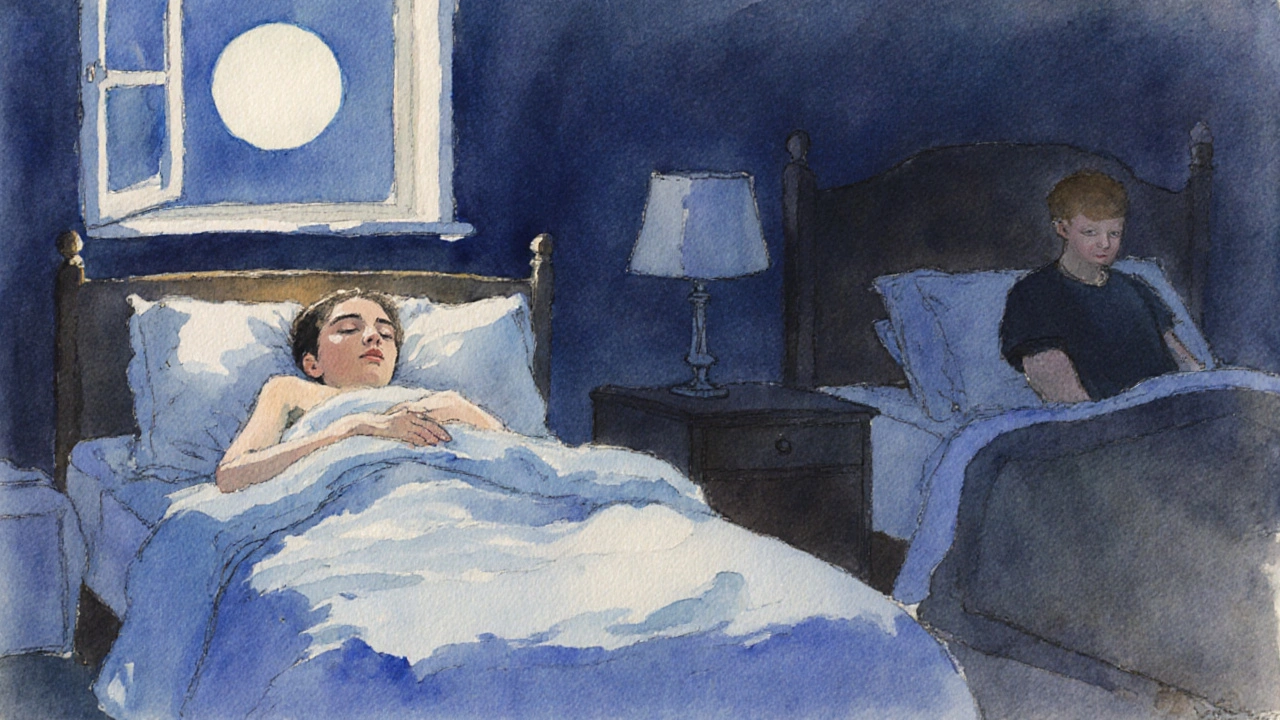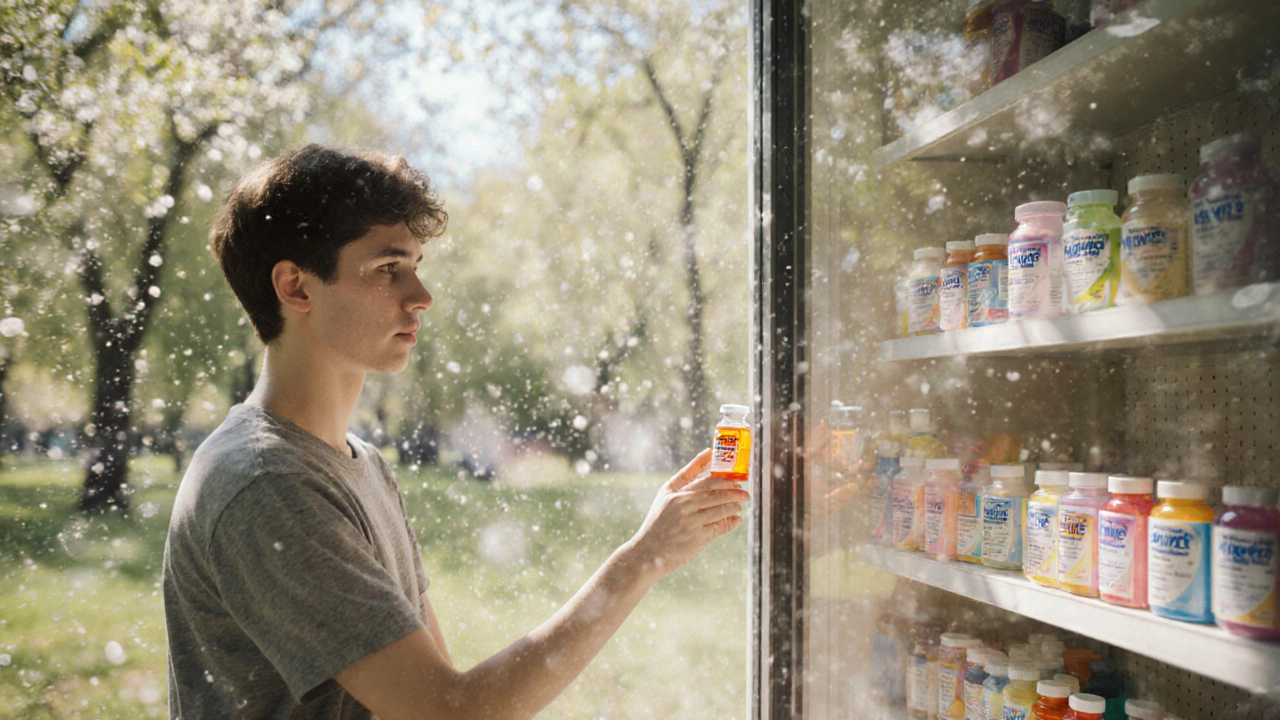Antihistamine Selector Tool
Antihistamine Options
Alavert
Loratadine
Low Sedation 1-3 hrsZyrtec
Cetirizine
Moderate Sedation 30-60 minAllegra
Fexofenadine
Very Low Sedation 15-30 minBenadryl
Diphenhydramine
High Sedation 15-30 minXyzal
Levocetirizine
Low-Moderate Sedation 1 hrClarinex
Desloratadine
Low Sedation 1-2 hrsComparison Table
| Brand (Generic) | Onset | Duration | Sedation Risk | Daily Dose | Price (30-tab pack) |
|---|---|---|---|---|---|
| Alavert (Loratadine) | 1-3 hrs | 24 hrs | Low | 10 mg | AU$12 |
| Zyrtec (Cetirizine) | 30-60 min | 24 hrs | Moderate (~15% drowsy) | 10 mg | AU$10 |
| Allegra (Fexofenadine) | 15-30 min | 12-24 hrs | Very Low | 180 mg | AU$18 |
| Benadryl (Diphenhydramine) | 15-30 min | 4-6 hrs | High (~80% sleepy) | 25-50 mg | AU$8 |
| Xyzal (Levocetirizine) | 1 hr | 24 hrs | Low-Moderate (~10% sleepy) | 5 mg | AU$14 |
| Clarinex (Desloratadine) | 1-2 hrs | 24 hrs | Low | 5 mg | AU$16 |
| Chlor-Trim (Chlorpheniramine) | 30-45 min | 4-6 hrs | Moderate-High | 4 mg | AU$9 |
Selected Antihistamine Details
Select an antihistamine from above to view details.
When seasonal sniffles or indoor allergens hit, you want relief fast, without a crash of drowsiness. Alavert is the over‑the‑counter brand of loratadine, a second‑generation antihistamine designed to block histamine receptors while staying out of the brain’s sleep‑centers. It’s marketed as a non‑sedating option for daily allergy control, but is it truly the best fit for you? Alavert often tops pharmacy shelves, yet dozens of alternatives compete on speed, potency, and price. This guide breaks down the science, the side‑effects, and the cost of the most common rivals so you can pick the one that matches your lifestyle.
Quick Takeaways
- Alavert (loratadine) offers 24‑hour relief with minimal sedation, but its onset can be 1‑3hours.
- Cetirizine works faster (30‑60minutes) but may cause mild drowsiness in up to 15% of users.
- Fexofenadine is the least sedating of the fast‑acting options, though it’s pricier.
- Diphenhydramine (Benadryl) knocks symptoms out in minutes but guarantees sleepiness.
- Levocetirizine and desloratadine sit between loratadine and cetirizine on speed and sedation.
How Alavert Works
Loratadine belongs to the second‑generation antihistamine family. It competes with histamine for the H1 receptor on cells lining the nose, eyes, and skin. By preventing histamine from binding, it reduces the classic allergy symptoms: itching, sneezing, runny nose, and watery eyes. Because the molecule is too large to cross the blood‑brain barrier efficiently, it stays out of the central nervous system, which explains the low‑sedation claim.
Core Attributes of Alavert
- Typical dose: 10mg once daily (one tablet).
- Onset of action: 1‑3hours after ingestion.
- Duration: Up to 24hours.
- Peak plasma level: ~2hours.
- Common side‑effects: Headache, dry mouth, occasional fatigue.
- Australian price (2025): About AU$12 for a 30‑tablet pack.
Alternative Antihistamines - At a Glance
| Brand (Generic) | Onset | Duration | Sedation Risk | Typical Daily Dose | Price (30‑tablet pack) |
|---|---|---|---|---|---|
| Alavert (Loratadine) | 1‑3h | 24h | Low | 10mg | AU$12 |
| Zyrtec (Cetirizine) | 30‑60min | 24h | Moderate (≈15% drowsy) | 10mg | AU$10 |
| Allegra (Fexofenadine) | 15‑30min | 12‑24h | Very Low | 180mg | AU$18 |
| Benadryl (Diphenhydramine) | 15‑30min | 4‑6h | High (≈80% sleepy) | 25‑50mg | AU$8 |
| Xyzal (Levocetirizine) | 1h | 24h | Low‑Moderate (≈10% sleepy) | 5mg | AU$14 |
| Clarinex (Desloratadine) | 1‑2h | 24h | Low | 5mg | AU$16 |
| Chlor‑Trim (Chlorpheniramine) | 30‑45min | 4‑6h | Moderate‑High | 4mg | AU$9 |
Deep Dive into the Alternatives
Cetirizine (Zyrtec)
Cetirizine is also a second‑generation antihistamine but it binds a bit more tightly to H1 receptors, which explains its faster onset. For people who need symptom relief within an hour-like outdoor workers or athletes-Zyrtec can be a better fit. About 15% of users report mild drowsiness, especially at higher doses, but most find it tolerable.
Fexofenadine (Allegra)
Fexofenadine is marketed as “non‑sedating” even compared with other second‑generations. Its chemical structure prevents it from crossing the blood‑brain barrier more effectively than loratadine. This makes it ideal for drivers or students who can’t afford a sleepy brain. The trade‑off is a slightly higher price and a need to take it with water on an empty stomach for optimal absorption.

Diphenhydramine (Benadryl)
Benadryl is a first‑generation antihistamine and the classic “take one and you’ll be sleepy” option. It works in 15‑30minutes, making it useful for sudden flare‑ups or for people who actually want the drowsiness to help them sleep. However, it can impair coordination, blur vision, and cause dry mouth. Because it crosses the blood‑brain barrier readily, it’s not recommended for daytime use unless you’re prepared for the crash.
Levocetirizine (Xyzal)
Levocetirizine is the active enantiomer of cetirizine, meaning it delivers the same antihistamine effect at half the dose. Its onset sits around an hour, and the sedation risk is a shade lower than cetirizine. Some users with chronic allergic rhinitis appreciate the once‑daily dosing and the slight edge in potency.
Desloratadine (Clarinex)
Desloratadine is the primary metabolite of loratadine-essentially the body’s “finished product.” It shares the low‑sedation profile but sometimes feels a touch faster than Alavert, especially in people who metabolise loratadine slowly. The usual dose is 5mg once daily, and it’s generally well‑tolerated.
Chlorpheniramine (Chlor‑Trim)
Chlorpheniramine is an older, first‑generation antihistamine that still appears in many combination cold medicines. It offers a quick onset but carries a moderate‑to‑high sedation risk. Because it’s cheap and widely available, it’s often chosen for short‑term use during a severe pollen spike.
Choosing the Right Antihistamine for You
Think of the decision as a simple checklist:
- When do you need relief? If you want fast action (<1hour), cetirizine, fexofenadine, or diphenhydramine are better choices.
- Can you tolerate any drowsiness? For minimal sedation, loratadine, desloratadine, or fexofenadine win. If you don’t mind a sleepy afternoon, diphenhydramine is fine.
- What’s your budget? Generic loratadine and cetirizine are the cheapest. Fexofenadine and desloratadine sit at the higher end.
- Any other health concerns? Those with liver impairment should avoid diphenhydramine (heavily metabolised by the liver). Pregnant or breastfeeding users usually stick with loratadine or cetirizine after doctor approval.
By answering these questions, most people land on either loratadine for its balance of cost and low sedation, or fexofenadine when a truly non‑sedating fast option is worth the extra dollars.
Safety and Side‑Effect Snapshot
| Drug | Common Side‑Effects | Serious Risks |
|---|---|---|
| Loratadine | Headache, dry mouth | Rare QT prolongation |
| Cetirizine | Mild drowsiness, fatigue | Rare hepatic enzyme elevation |
| Fexofenadine | Headache, nausea | Rare cardiac arrhythmia in high doses |
| Diphenhydramine | Strong drowsiness, dry mouth, urinary retention | Anticholinergic toxicity in the elderly |
| Levocetirizine | Drowsiness (low), taste alteration | Very rare hypersensitivity |
| Desloratadine | Headache, dry throat | Rare liver enzyme changes |
| Chlorpheniramine | Drowsiness, dizziness | Potential for QT prolongation with high doses |
Cost Overview in Australia (2025)
Pricing varies by pharmacy chain and whether you buy generic or brand‑name packs. Below is a quick snapshot for a standard 30‑tablet supply:
- Loratadine (generic) - AU$8‑10
- Loratadine (Alavert) - AU$12
- Cetirizine - AU$10
- Fexofenadine - AU$18
- Diphenhydramine - AU$8
- Levocetirizine - AU$14
- Desloratadine - AU$16
If you rely on a chronic daily dose, the generic loratadine or cetirizine will save you the most over a year. For occasional use, a higher‑priced fast‑acting option may actually be cheaper because you’ll take fewer tablets.
Bottom Line
If you need a reliable, non‑sedating daily pill and price matters, Alavert (loratadine) remains a solid pick. If you can tolerate a little sleepiness and want faster relief, Zyrtec (cetirizine) or Allegra (fexofenadine) might suit you better. For nighttime flare‑ups or when you actually want to sleep, Benadryl (diphenhydramine) is the go‑to, but don’t use it during the day.

Frequently Asked Questions
Can I take loratadine and cetirizine together?
Combining two second‑generation antihistamines typically offers no extra benefit and raises the risk of side‑effects. Doctors usually advise picking one that fits your timing and sedation tolerance.
Is loratadine safe for children?
Yes, a pediatric dose (5mg) is approved for kids 2‑5years old, and 10mg for those 6years and older. Always follow the label or a doctor’s advice.
Will loratadine interfere with alcohol?
Loratadine’s low sedation means moderate alcohol consumption usually isn’t a problem, but heavy drinking can amplify drowsiness for any antihistamine.
How does fexofenadine differ from loratadine chemically?
Fexofenadine is a metabolite of terfenadine and carries a sulfonic acid group that blocks it from entering the brain, which is why it stays non‑sedating even at higher doses.
Can I use loratadine for hives?
Yes, loratadine works well for chronic urticaria (hives). Some patients need a higher daily dose (up to 20mg) under medical supervision.


16 Comments
Brooke Bevins
October 4, 2025 AT 00:00Alavert may sit on the top shelf of the pharmacy, but it isn’t the universal answer for every sneezer out there.
The its 1‑3 hour onset means you have to plan ahead, which many folks with sudden pollen spikes can’t afford.
The low‑sedation claim holds up for most, yet a small percentage still feel a fuzzy brain fog.
When you compare price, AU$12 for thirty tablets is decent, but not the cheapest on the block.
In terms of duration, the 24‑hour coverage is solid and lets you grab a single dose daily.
Pharmacokinetically, loratadine’s metabolism via CYP3A4 can be slowed by certain antibiotics, raising plasma levels.
That interaction risk is something you should flag if you’re on a cocktail of meds.
If you need rapid relief before a meeting, a faster antihistamine like Zyrtec or Allegra will outpace Alavert.
However, the trade‑off might be a modest chance of drowsiness, especially with cetirizine.
For night‑time users, Benadryl’s high sedation can double as a sleep aid, albeit at the cost of morning grogginess.
Levocetirizine (Xyzal) offers an intermediate onset of about an hour with a lower drowsiness profile than Zyrtec.
Desloratadine (Clarinex) often feels a tad quicker than Alavert for fast metabolisers, thanks to its direct active form.
Chlorpheniramine is cheap and quick but its moderate‑high sedation makes it unsuitable for driving.
Ultimately, the “best” choice aligns with your priority: speed, cost, or staying awake.
If you can tolerate waiting a couple of hours, Alavert’s low‑sedation and stable 24‑hour window make it a solid daily workhorse.
Otherwise, consider the faster, slightly more sedating options and pick the one that fits your schedule. 😊
Andy McCullough
October 4, 2025 AT 02:47The pharmacodynamic profile of loratadine reveals selective H1 antagonism with minimal central nervous system penetration, which is why sedation remains low.
However, its hepatic biotransformation via CYP3A4 and CYP2D6 introduces potential drug‑drug interactions that clinicians must monitor.
Onset latency of 1‑3 h correlates with the time required for peak plasma concentration (Tmax) after oral administration.
For patients on polypharmacy regimens, consider a non‑CYP substrate like fexofenadine to mitigate metabolic interference.
In summary, Alavert’s safety margin is solid, but its kinetic profile may not suit acute symptom flare‑ups.
Zackery Brinkley
October 4, 2025 AT 05:33That makes sense – if you’re taking a lot of meds, a drug that doesn’t hit the liver enzymes is a safer bet.
Just remember to check the label for anything that says “may cause drowsiness”.
It’s always good to have a backup like Zyrtec on hand for fast relief.
Luke Dillon
October 4, 2025 AT 08:20Hey folks, I’ve been using Alavert for a couple of seasons now and it’s pretty reliable for day‑to‑day pollen.
I love that I can pop one tablet in the morning and forget about it.
The only downside is waiting a bit for it to kick in if you’re caught off guard.
Otherwise, it’s a solid choice if you don’t want to feel groggy.
Elle Batchelor Peapell
October 4, 2025 AT 11:07Think of Alavert like a quiet philosopher in the pharmacy aisle – it doesn’t shout, it just does its thing.
You sit, you wait, and eventually the calm settles in, like a meditative tide.
But if you’re sprinting to a meeting, you might need a faster, louder voice like Allegra’s.
In the grand symphony of antihistamines, each has its own instrument.
Choose the one that matches the tempo of your day, and you’ll stay in harmony.
Jeremy Wessel
October 4, 2025 AT 13:53Alavert works fine for most, but you have to wait.
Laura Barney
October 4, 2025 AT 16:40Picture this: you’re dancing through a field of daisies, and suddenly the pollen hits like confetti at a parade.
Alavert is the friend who calmly hands you a napkin, while Benadryl is that wild cousin who shouts, “Let’s party!” and then knocks you out on the couch.
If you crave the mellow vibe, stick with Alavert; if you need a dramatic crash, Benadryl’s your ticket.
Just remember, the universe rewards the balanced, not the over‑the‑top.
Jessica H.
October 4, 2025 AT 19:27The comparative analysis presented is commendably thorough, yet it could benefit from an explicit citation of pharmacoeconomic data to substantiate the cost‑effectiveness claims.
A concise tabular summary of adverse event frequencies would further enhance the clinical utility of the document.
Overall, the exposition maintains a high standard of scholarly rigor.
Tom Saa
October 4, 2025 AT 22:13While the brevity of the previous remark is appreciated, it omits the nuanced interplay between receptor affinity and patient‑specific metabolism.
Such subtleties often dictate real‑world efficacy more than textbook onset times.
John Magnus
October 5, 2025 AT 01:00Let’s cut the fluff – Alavert’s pharmacokinetics are solid, but its pharmacodynamics lag behind the rapid‑action contenders.
If you need to sprint through allergy season, you’ll thank Zyrtec’s 30‑minute surge and Allegra’s sub‑30‑minute strike.
Don’t be fooled by the “low‑sedation” hype; real‑world data shows a non‑trivial percentage still report drowsiness, especially when combined with antihypertensives.
On the cost front, Alavert sits in the mid‑range, but bulk generic loratadine can drop below $5 CAD for a month’s supply, making the brand name a marginal premium.
Bottom line: choose based on your time‑sensitivity matrix, not just brand loyalty.
Marc Clarke
October 5, 2025 AT 03:47Honestly, I just grab whatever’s on sale and hope it works.
If it doesn’t, I switch – no big drama.
Most of these meds are pretty interchangeable for me.
angelica maria villadiego españa
October 5, 2025 AT 06:33Great rundown! I’ve tried Alavert and Zyrtec – Alavert is my go‑to for work days, Zyrtec for weekend hikes.
Ted Whiteman
October 5, 2025 AT 09:20Everyone’s acting like Alavert is the holy grail, but let’s be real – it’s just a middle‑aged dad at the party, not the rockstar.
If you want fireworks, you need the faster, more intense options, even if they come with a side of drowsy hangover.
Don’t settle for “low sedation” when you can have “no sedation” and still get relief.
Dustin Richards
October 5, 2025 AT 12:07While I appreciate the comprehensive overview, I find the tone oscillates between overly casual and unexpectedly formal.
A consistent approach would aid readability for diverse audiences.
Nevertheless, the content remains valuable.
Vivian Yeong
October 5, 2025 AT 14:53The analysis is decent, but it glosses over the variability in individual response.
suresh mishra
October 5, 2025 AT 17:40Alavert’s onset is slower than Zyrtec, but its sedation profile is better.
Consider your schedule when choosing.